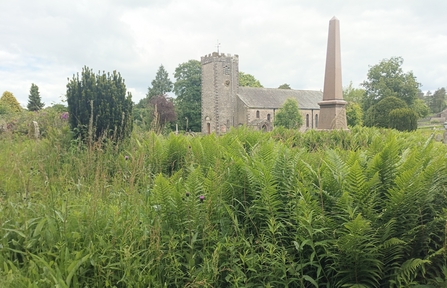
Ravenstonedale Churchyard is one of Cumbria's County Wildlife Sites © Beth Lightburn

Ravenstonedale Churchyard is one of Cumbria's County Wildlife Sites © Beth Lightburn
The 18th century church of St Oswald’s in Ravenstonedale is not just a place of worship and an active part of village life: its churchyard is home to a huge variety of beautiful meadow plants. It’s surrounded by lilac, elder, and yew trees, and in summer months, hawkweed, buttercup, white clover, cuckoo flower, lady’s mantle, pignut, bistort, melancholy thistle and meadowsweet burst into life around the gravestones.
The churchyard at St Oswald’s is just one of the very special wildlife places that are being re-discovered through a Cumbria-wide nature partnership. The County Wildlife Sites Project is conducting a new survey of 1,600 County Wildlife Sites across Cumbria. These are very special locations that are recognised and celebrated for their importance for wildlife.
County Wildlife Sites, also known as Local Wildlife Sites, play a vital role in helping nature to thrive across the Cumbrian landscape. They provide corridors and stepping stones for wildlife to move through the county. They link the better-known areas for wildlife, such as nature reserves and protected sites, adding to the mosaic of habitats for nature. They include everything from woodlands, hay meadows and churchyards to roadside verges, moorlands, lakes and riverbanks. They’re owned and managed by a range of landowners, including private individuals, charities, utility companies, and public bodies.
The project is a partnership between Cumberland Council, Cumbria Biodiversity Data Centre, Cumbria Local Nature Partnership, Cumbria Wildlife Trust, Lake District National Park Authority, Natural England, Westmorland and Furness Council, and Yorkshire Dales National Park Authority.
Specialist field officers carry out habitat and species surveys in some of the most stunning parts of the county. Once the surveys are complete, they present reports to an expert panel of professionals and experienced volunteer botanists who have detailed knowledge of the county’s wildlife. They decide whether these places still meet the selection criteria, or if further management advice or re-designation is needed.
In the last year and a half, the Cumbria County Wildlife Sites Project has surveyed more than 100 locations across the county. St Oswald’s churchyard is just one of the highlights identified by the team: between the church and the trickling beck, the ruins of the Gilbertine monastery provide another special habitat for lichens, mosses and ferns which thrive in this shaded damp corner of the grounds. It shows how important habitats can be managed for both nature and the people using the church.
Emily Stewart-Rayner from Cumbria Wildlife Trust describes other highlights from the survey: “Driving along the back roads of Cumbria, you may see vibrant flashes of colour as you pass one of the roadside verges designated as a County Wildlife Site. Full of meadow grasses with wonderful names such as Yorkshire fog, cock’s-foot, sweet vernal, tufted hair and crested dog’s-tail, these habitats are key corridors for pollinators travelling around the county too. Just off the A595, between Bolton Low Houses and Mealsgate, the rich diversity of plants including oxeye daisies, crosswort, knapweed, common spotted orchids, meadowsweet, woundwort and stinking iris provide a wide border backed by traditional hedgerow trees including hawthorn, holly, ash, blackthorn, willow, wild cherry and gorse, leading to the farmland beyond.”
Emily explains why surveying these places is so important: “Many of them haven’t been surveyed since their designation many decades ago, but understanding their condition is really important in giving us a snapshot of how wildlife habitats across Cumbria are faring now. While County Wildlife Sites aren’t protected by law, they’re recognised as Areas of Particular Importance for Biodiversity in Cumbria’s draft Local Nature Recovery Strategy. By monitoring how diverse these places are for wildlife, we can add to the regional picture of where best to focus efforts for dealing with increasing pressures to the natural world.”